
Price Controls in A Free Market
“There is no such thing as a free lunch.”

This has been a staple of economic education for years. Nothing is free and the thought that something can be given for free, with no relative cost, crosses over beyond the realm of naivety into ignorance and unrealistic expectations. Price controls, the establishment and maintenance of maximum price levels for basic goods and services by the government, are sold as a possible reality when in truth, they come with dangerous repercussions if not controlled intelligently. Politicians assure and guarantee a brilliant vision of possibilities in order to gain the necessary public vote only to intermittently generate unattainable misconceptions for the economy. The fantasy of a free lunch is the concept trumpeted loudly with gusto, and price controls deliver that fantasy until the truth of difference between prices and costs is revealed, the truth of supply and demand is explained, and a free market economy becomes a vision in place of a reality.
Prices and costs are two completely separate entities that are commonly mistaken for each other. Prices are signals that communicate the realities of relative scarcities and relative costs of production. Costs do not vanish with disregard and evasion but rather, persist and compound repeatedly, causing escalations of other means such as taxes, prices, deterioration in quality, or the creation of black markets. Promising something for nothing is as counterproductive as trying to control the electric issue in California. The cost of running electricity through a house does not diminish just because the government lowers the price; instead it begins to create a deficit because what is being expended is greater than what is being replenished. “… price controls do nothing more than change the monetary signals, without changing the real costs of anything.” Issues such as rent control, a law placing a maximum price or rent ceiling on what landlords may charge, have actually been proven to compensate for insufficiencies in the housing market. However, legally set minimums of hourly rates known as the minimum wage, will result in a surplus of unemployed workers who are willing to work at the higher rate. Logically, the reduced number of jobs available instantly allows employers to operate with expanding selectivity. Subsequently, laborers who fail to satisfy new selective requirements, suffer immediate expropriation from the labor pool, thus increasing the unemployment rate substantially. Price controls are usually imposed in order to keep prices from rising but if allowed, those prices would rise and fall in accordance with supply and demand.
When the government imposes price controls, prices are kept artificially low. However, for every action there is always an equal and opposite reaction resulting in reduced quantities supplied. Price controls always lead to a shortage since the economy is fully compliant to the laws of supply and demand when allowed to operate as such. Producers will not supply as equivalent a quantity of product at reduced rates as they would at elevated rates and the opposite is true; consumers will demand more when the price is kept artificially low by price controls and will purchase anything low-priced in wasteful excess causing a shortage. In the absence of price controls, a shortage is usually a passing trend and prices are free to rise and fall. When prices rise, consumers purchase less, producers produce more, and the gap is closed therefor eliminating the shortage. Price controls however, prevent shortages from ending and prevent a so-called free market from functioning to its full potential.
In a free market economy, prices rise because the amount demanded exceeds the amount supplied at the existing products and vice-a-versa; in a free market, prices fall because the amount supplied exceeds the amount demanded at the existing prices. When the government intervenes and sets a price ceiling, a maximum price set lower than the equilibrium price, a shortage occurs. A surplus ensues when the government sets a price floor, a minimum price set above the equilibrium, causing a decrease in consumer desire to spend. The real goal in any situation in which the government would like to instill price controls, should be reduced government spending. Expending more resources than what are available results in a deficit ensuing debt. This debt cannot be remedied with taxes and price controls but the creation and implementation of a budget and spending plan. Thomas Sowell said, “Economic policies need to be analyzed in terms of the incentives they create, rather than the hopes that inspired them.” Don’t promise a free lunch, something that is non-existent, in hopes of appealing to the naïve masses and avoiding the actual issues. The appeal of price controls is understandable but its failure to protect consumers is not. Reducing the amount of trade in an economy and creating incentives that lead to wasted resources hardly qualifies as development. The consequence is perplexity and confusion of economics, misunderstanding of concepts, and inevitably less confidence in the government and the economy.
Economists, in general, do not approve the use of price controls except for brief periods during emergencies. The concept was never designed for long-term usage because it distorts reality and the allocation of resources. Price controls, intended to improve efficiency in a market that fails to achieve optimal productivity due to mitigating contexts, tend to rather create imbalances when inflicted upon an otherwise proficient and viable market.